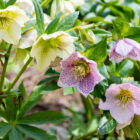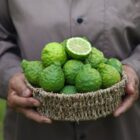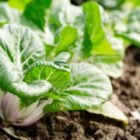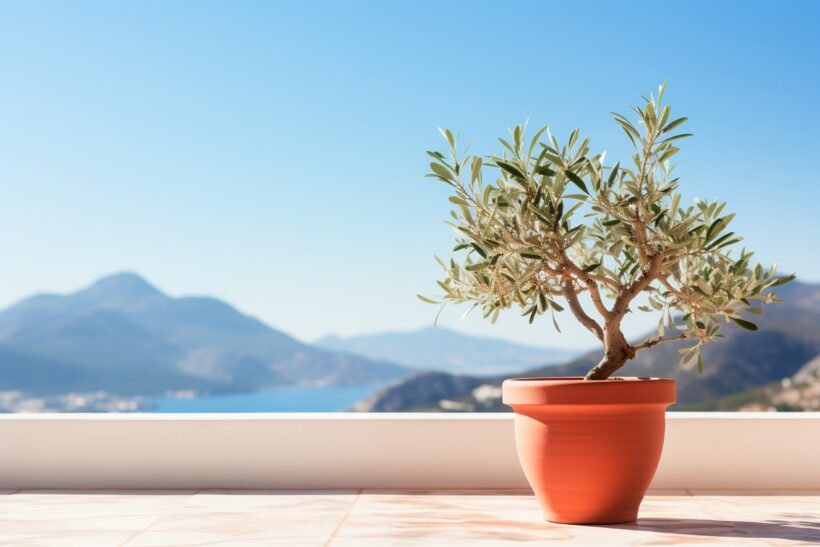
Bonsai olive tree: tips on care and fertilisation
Bonsai olive tree – an universe of emotions
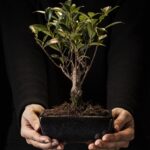 There are many types of Mediterranean plants that have always fascinated connoisseurs of the art of bonsai. Among these the ideal one for bonsai planting is the olive tree. As well as being an extraordinarily beautiful plant, the bonsai olive offers the possibility of connecting with Mediterranean history, culture and nature. However, it is not enough to have a good knowledge of botany to ensure proper growth of this plant. Growing a bonsai olive tree requires time, dedication, love and passion. Elements that create an emotional bond with the plant and at the same time a deeper connection with nature. In short, growing a bonsai tree is not ‘gardening‘. Instead, it is an activity that involves artistic and meditative aspects. Bonsai art, therefore, offers a unique opportunity for personal expression and inner growth.
There are many types of Mediterranean plants that have always fascinated connoisseurs of the art of bonsai. Among these the ideal one for bonsai planting is the olive tree. As well as being an extraordinarily beautiful plant, the bonsai olive offers the possibility of connecting with Mediterranean history, culture and nature. However, it is not enough to have a good knowledge of botany to ensure proper growth of this plant. Growing a bonsai olive tree requires time, dedication, love and passion. Elements that create an emotional bond with the plant and at the same time a deeper connection with nature. In short, growing a bonsai tree is not ‘gardening‘. Instead, it is an activity that involves artistic and meditative aspects. Bonsai art, therefore, offers a unique opportunity for personal expression and inner growth.
Bonsai olive tree – characteristics
The olive (olea europea) is a popular plant among bonsai enthusiasts due to its unique characteristics. It originates from Mediterranean countries and is a symbol of peace, wisdom, longevity and resilience. The olive tree, in particular, has small leaves and a rustic appearance. Its bark is rough and its trunks and branches are twisty. These characteristics give the bonsai tree a striking and antique appearance. Moreover, it is a very hardy plant that adapts easily to different types of soils and climates. It can, therefore, tolerate low temperatures but not below -3 degrees below zero. However, even though it is a hardy plant, it is always important to provide the necessary care and attention to ensure the continual health and beauty of the olive bonsai tree.
Olive bonsai – cultivation guide
Like all plants, the olive bonsai tree also requires a few small steps during cultivation to enable it to thrive. Let us analyse them in detail:
Location
The olive bonsai tree loves direct sunlight and a mild climate. Therefore, its ideal location is a place where it receives at least 6-8 hours of sunlight per day. Doctor Bioges recommends giving the plant an even exposure to light. This ensures that the plant grows evenly and does not overgrow in one specific direction. During the summer months, it is best to protect it from high temperatures and ensure that it has adequate ventilation. Also in winter it is advisable to protect it from cold temperatures and frost, avoiding temperature fluctuations.
Watering the olive bonsai tree
Watering is a key operation in the care of bonsai trees. Firstly, observe your plant carefully and adapt this practice to its needs. The bonsai olive tree, in fact, requires a specific watering regime. In particular, it requires filtering the water if it is calcareous. It is important to pour the water slowly and evenly, avoiding water stagnation. The soil must therefore not be dry but moist. Avoid wetting the leaves. Especially in direct sunlight in order to avoid sunburn. During the winter season, it is advisable to reduce watering. In any case, always ensure that the soil does not dry out completely.
Pruning
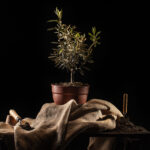 This operation not only maintains the desired shape, but also promotes proper branching and healthy growth of the tree. However, bonsai pruning requires precision and care, but at the same time it needs careful handling, analysing the plant’s response to it. Firstly, it is necessary to use sharp and clean scissors or shears. This reduces the risk of infection or damage to the plant. It is advisable to do the most drastic pruning during the winter season, when the plant is in a state of dormancy. Conversely, a lighter pruning can be performed throughout the year, and is necessary to remove dry leaves, dead and/or damaged branches. In addition, it is preferable to remove any epicormic and basal shoots that do not serve the formation of the plant. After pruning, it is necessary to brush or spray with Propolis, which is a natural healer of cut wounds.
This operation not only maintains the desired shape, but also promotes proper branching and healthy growth of the tree. However, bonsai pruning requires precision and care, but at the same time it needs careful handling, analysing the plant’s response to it. Firstly, it is necessary to use sharp and clean scissors or shears. This reduces the risk of infection or damage to the plant. It is advisable to do the most drastic pruning during the winter season, when the plant is in a state of dormancy. Conversely, a lighter pruning can be performed throughout the year, and is necessary to remove dry leaves, dead and/or damaged branches. In addition, it is preferable to remove any epicormic and basal shoots that do not serve the formation of the plant. After pruning, it is necessary to brush or spray with Propolis, which is a natural healer of cut wounds.
Pinching
Pinching should be regularly performed as it helps to maintain smaller leaf size and promote better branching. In olive bonsai, it is best to carry out this cultivation practice several times during the active growing season. In particular, it is advisable to do so once there is new growth at the ends of the branches.
Repotting olive bonsai
 Olive bonsai should be repotted periodically to ensure the health and development of the plant. In particular, it needs repotting every 2-3 years for growing bonsai trees, and every 4-5 years for more mature ones. However, the frequency depends on the size of the pot and the growth of the roots. The ideal time for repotting is spring. During the spring season, the plant will be able to recover from the stress of repotting. The use of the product Radikal Sprinter proves to be beneficial for a quick recovery. In addition, it is advisable to stop fertilising in order to allow the bonsai to adapt to its new environment. Only after a couple of weeks, if the plant has recovered, is it possible to start fertilising. Repotting, therefore, is a crucial moment in the life of a plant. This operation needs to take place with care to ensure a smooth transition and healthy growth of the plant.
Olive bonsai should be repotted periodically to ensure the health and development of the plant. In particular, it needs repotting every 2-3 years for growing bonsai trees, and every 4-5 years for more mature ones. However, the frequency depends on the size of the pot and the growth of the roots. The ideal time for repotting is spring. During the spring season, the plant will be able to recover from the stress of repotting. The use of the product Radikal Sprinter proves to be beneficial for a quick recovery. In addition, it is advisable to stop fertilising in order to allow the bonsai to adapt to its new environment. Only after a couple of weeks, if the plant has recovered, is it possible to start fertilising. Repotting, therefore, is a crucial moment in the life of a plant. This operation needs to take place with care to ensure a smooth transition and healthy growth of the plant.
Fertilising olive bonsai trees
Each plant has its own requirements, and these vary depending on the age of the plant, environmental conditions, pot size and general health. Therefore, it is important to observe the bonsai tree carefully. Observing the plants will help you better understand their specific needs and better calibrate fertilisation. Firstly, you have to bear in mind that the fertilisation level of pot plants is different from those in the garden. In particular, the nutrients present in the substrate are limited and will quickly deplete. It is therefore necessary to provide fertiliser periodically. Finally, the choice between organic fertiliser and liquid mineral fertiliser is also fundamental. In particular, organic fertilisers are frequently preferable due to their long-term effect on the soil and general plant health. Liquid mineral fertilisers, on the other hand, are useful for quick and targeted nutrition. However, experts in this field combine the two fertiliser types to obtain the benefits from both methods.
Pests and fungal diseases – how to intervene?
The olive bonsai tree is susceptible to attack by cochineal and mites. It can also be attacked by fungal diseases such as powdery mildew, rust and root rot. These phenomena can be prevented with the use of resistance inducers. These are alternatives to classic plant protection and eco-friendly products, which are also becoming popular in gardening and bonsai care. Indeed, consumer awareness of the use of organic products that are safe for the user and the environment has grown. Ultimately, resistance inducers are able to activate natural defence mechanisms against biotic and abiotic stresses by decreasing the use of chemicals that can undermine plant health. However, in the case of severe infestations and/or diseases, an expert should be consulted for specific advice and more targeted treatments.
Fertiliser for bonsai depending on the plant’s stage of development
Request your free fertilisation plan by sending an email to info@biogesandco.com specifying the type of plants and your needs (growth, flowering etc.) or contact us on Facebook.
Are you a beginner looking for the right product for your bonsai as spring approaches?
Doctor Bioges recommends you try our Bonsai Kit for spring treatments: it also includes a fertilisation plan to help you make your bonsai even more beautiful, without making any mistakes!
If you have any other questions, the Bioges team is always ready to assist you. You can contact us directly on our social networks or by sending an e-mail to info@biogesandco.com

